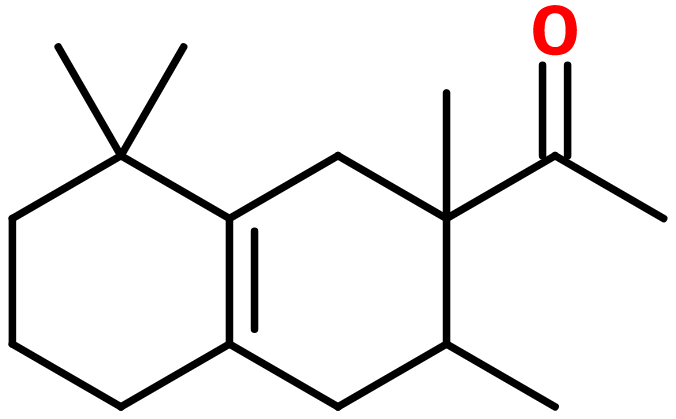Iso E Super®
Synthétique
Woody > Ambergris > Violet Flower > Cedar

Crédits photo: ScenTree SAS
Other names :
Amberonne® ; Orbitone® ; Arborone® ; 1-(2,3,8,8-tetramethyl-1,3,4,5,6,7-hexahydronaphthalen-2-yl)ethanone ; 1,2,3,4,5,6,7,8-octahydro-2,3,8,8-tetramethyl-2-acetonaphthone ; Amber fleur ; Isoamber super ; Amberfleur ; Ambergris ketone ; Amberix super ; Amberlan ; Ambroise super ; Anthamber ; Boisvelone ; Isocyclemone E ; Dimethyl myrcetone ; Hamber ; Iso gamma super ; Methyl cyclomyrcetone ; Patchouli ethanone ; Sylvamber ; Timbersilk ; Timbrone supra ; Iso velvetone
Volatility :
Base
Uses in perfumery :
Iso E Super® is used in masculine, woody and ambery notes as a woody base. Allows to bring a light violet flower note to woody accords.
Natural availability :
Iso E Super® is not available in its natural state.
Year of discovery :
Discovered in 1956. Iso E Super® was first patented in 1973, by scientists John B. Hall and James M. Sanders.
Other comments :
The name of Iso E Super® comes from the contraction of ISOcyclomyrcetone Ethanone, and the SUPERior quality which has been made accessible since the improvement of the manufacturing process. Often called 'bois-violette'.
From 1993, each company was free to produce its own Iso E Super®. The current production of the molecule is 1800 tons per year.
From 1993, each company was free to produce its own Iso E Super®. The current production of the molecule is 1800 tons per year.
Price Range :
€€
Stability :
Stable in perfumes and diverse functional bases

Crédits photo: ScenTree SAS
- Molecular formula :
- C16H26O
- Molecular Weight :
- 234,38 g/mol
- Density :
- 0,964
- Flash Point :
- 134°C
- Fusion Point :
- Donnée indisponible.
- Appearance :
- Colorless liquid
- Log P :
- 5,65
- Boiling Point :
- 290°C
- Detection Threshold :
- Donnée indisponible.
Synthesis route :
Iso E Super® is synthesized by a Diels-Alder reaction between Myrcene and 3-methyl-3-penten-2-one in the presence of aluminum chloride. The cyclization of the intermediate product obtained is made thanks to the action of phosphoric acid. This cyclization gives birth to two isomers : Iso E Super® and Arborone, in 95/5 proportions.
Synthesis precursor :
Iso E Super® is not a precursor to the synthesis of another compound of olfactory interest.
Isomerism :
Iso E Super® is composed by more than 20 isomeric molecules. The molecule called Isocyclemone in its pure state, has almost no smell, but the Iso E Super® called '' Plus '', so-called Arborone, found at between 2 and 5% in the commercialised Iso E Super®, has a very strong smell (10 000 times more powerful than Iso E Super), and is responsible for the smell of Iso E Super®. Iso E Super® Plus alone is not marketed because its production is too expensive.
- EINECS number :
- 259-174-3
- FEMA number :
- Donnée indisponible.
- JECFA number :
- Donnée indisponible.
- FLAVIS number :
- Donnée indisponible.
- Allergens :
- This ingredient does not contain any allergen.
- IFRA :
- This ingredient is restricted by IFRA
- Restriction type :
- RESTRICTION
- Cause of restriction :
- DERMAL SENSITIZATION AND SYSTEMIC TOXICITY
- Amendment :
- 49
- Quantitative limit on the use :
-
Cat.1 Cat.2 Cat.3 Cat.4 Cat.5A Cat.5B Cat.5C Cat.5D Cat.6 0,41 % 1,1 % 0,41 % 20 % 5,1 % 0,56 % 0,76 % 0,19 % 0,0093 % Cat.7A Cat.7B Cat.8 Cat.9 Cat.10A Cat.10B Cat.11A Cat.11B Cat.12 0,67 % 0,67 % 0,19 % 2,4 % 2,4 % 6,6 % 0,19 % 0,19 % No Restriction - Restriction type :
- RESTRICTION QRA
- Cause of restriction :
- SENSITIZATION
- Amendment :
- 43
- Quantitative usage limits :
-
Cat.1 Cat.2 Cat.3 Cat.4 Cat.5 Cat.6 Cat.7 Cat.8 Cat.9 Cat.10 Cat.11 1,34 % 1,73 % 7,1 % 21,4 % 11,2 % 34,2 % 3,6 % 2 % 5 % 2,5 % Not Restricted
To learn more about IFRA's standards : https://ifrafragrance.org/safe-use/library
ScenTree is solely responsible for the information provided here.



